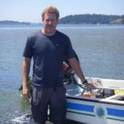
Article
Mangrove Peat Collapse Following Mass Tree Mortality: Implications for Forest Recovery from Hurricane Mitch
Journal of Ecology
Document Type
Article
Publication Date
12-1-2003
Keywords
- Mangrove forest,
- rod surface elevation table,
- sediment elevation,
- subsidence,
- vertical accretion
Disciplines
Abstract
- 1 We measured sediment elevation and accretion dynamics in mangrove forests on the islands of Guanaja and Roatan, Honduras, impacted by Hurricane Mitch in 1998 to determine if collapse of underlying peat was occurring as a result of mass tree mortality. Little is known about the balance between production and decomposition of soil organic matter in the maintenance of sediment elevation of mangrove forests with biogenic soils.
- 2 Sediment elevation change measured with the rod surface elevation table from 18 months to 33 months after the storm differed significantly among low, medium and high wind impact sites. Mangrove forests suffering minimal to partial mortality gained elevation at a rate (5 mm year−1) greater than vertical accretion (2 mm year−1) measured from artificial soil marker horizons, suggesting that root production contributed to sediment elevation. Basin forests that suffered mass tree mortality experienced peat collapse of about 11 mm year−1 as a result of decomposition of dead root material and sediment compaction. Low soil shear strength and lack of root growth accompanied elevation decreases.
- 3 Model simulations using the Relative Elevation Model indicate that peat collapse in the high impact basin mangrove forest would be 37 mm year−1 for the 2 years immediately after the storm, as root material decomposed. In the absence of renewed root growth, the model predicts that peat collapse will continue for at least 8 more years at a rate (7 mm year−1) similar to that measured (11 mm year−1).
- 4 Mass tree mortality caused rapid elevation loss. Few trees survived and recovery of the high impact forest will thus depend primarily on seedling recruitment. Because seedling establishment is controlled in large part by sediment elevation in relation to tide height, continued peat collapse could further impair recovery rates.
DOI
https://doi.org/10.1046/j.1365-2745.2003.00841.x
Subjects - Topical (LCSH)
Mangrove forests--Hurricane effects--Honduras--Guanaja; Mangrove forests--Hurricane effects--Honduras--Roatán; Mangrove forests--Mortality--Honduras--Guanaja; Mangrove forests--Mortality--Honduras--Roatán; Peat bogs--Honduras--Guanaja; Peat bogs--Honduras--Roatán; Hurricane Mitch, 1998
Geographic Coverage
Guanaja Island (Honduras); Roatán (Honduras)
Genre/Form
articles
Type
Text
Language
English
Format
application/pdf
Citation Information
Cahoon, D. R., Hensel, P., Rybczyk, J., McKee, K. L., Proffitt, C. E. and Perez, B. C. (2003), Mass tree mortality leads to mangrove peat collapse at Bay Islands, Honduras after Hurricane Mitch. Journal of Ecology, 91: 1093–1105. doi: 10.1046/j.1365-2745.2003.00841.x
